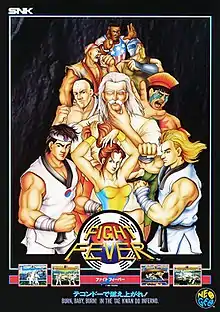Fight Fever
Fight Fever[lower-alpha 2] is a 1994 2D fighting video game for the Neo-Geo MVS System. It is the first Korean Neo Geo title ever officially released, as well as the first game developed and released by Korean publisher of SNK games, Viccom (빅콤).[2] A port for the Neo Geo CD was also showcased but never released.[3]
| Fight Fever | |
|---|---|
 | |
| Developer(s) | Viccom[lower-alpha 1] |
| Publisher(s) |
|
| Platform(s) | Arcade |
| Release | |
| Genre(s) | Fighting |
| Mode(s) | |
| Arcade system | Neo Geo MVS |
Gameplay
.png.webp)
The game plays similarly to other 2D versus fighting games, especially both SNK's Fatal Fury 2 and Art of Fighting. In fact, it shapes itself after Fatal Fury 2 while it uses Art of Fighting's game engine. There are 8 characters to select from and two boss characters (the first boss character is only playable in two player mode). The object of the game is to win two matches out of three. Each character has a set of moves in addition to two basic punches and kicks. Each character also has a super move called a "Danger Move", which are similar to the Desperation Moves from Fatal Fury 2. Players also have the ability to taunt others, but unlike games such as Art of Fighting, this has no effect and would actually leave the player open to attacks.
There are two bonus games that reward the player with points dependent on how successful the player is. The first game is a brick-breaking game that requires rapid pressing of the A button. The second bonus game requires the player to break boards held up by trainers popping out of the left and right sides. Both bonus games were also in Capcom's 1987 arcade game, Street Fighter, as well as one of them also in Midway's 1992 arcade game, Mortal Kombat and the ones in Art of Fighting.
Characters
 Han Baedal – The protagonist of the game. A taekwondo exponent who appears to be a cross between Ryu and Ryo Sakazaki.
Han Baedal – The protagonist of the game. A taekwondo exponent who appears to be a cross between Ryu and Ryo Sakazaki. Miyuki – A dancer and only female character in the game.
Miyuki – A dancer and only female character in the game. Rophen Heimer – A German bartender and martial artist.
Rophen Heimer – A German bartender and martial artist. Magic Dunker – A basketball player who is most likely named after Magic Johnson.
Magic Dunker – A basketball player who is most likely named after Magic Johnson. Golrio – A fat indigenous Brazilian warrior with the ability to throw fireballs and spin around quickly against his opponents.
Golrio – A fat indigenous Brazilian warrior with the ability to throw fireballs and spin around quickly against his opponents. Nick Commando – A large masked soldier who can throw grenades and charge at the foe.
Nick Commando – A large masked soldier who can throw grenades and charge at the foe. Chintao – A Chinese martial monk.
Chintao – A Chinese martial monk. Kim Hoon – A palette-edit, semi-clone and rival of Han Baedal.
Kim Hoon – A palette-edit, semi-clone and rival of Han Baedal. Master Taekuk – An old taekwondo master who can stretch out his arms and slam the opponent.
Master Taekuk – An old taekwondo master who can stretch out his arms and slam the opponent. Karate Kenji – The final boss of the game. He was voiced by Masaki Usui, who also voiced Ryo Sakazaki from the Art of Fighting series and Haohmaru from the Samurai Shodown series.
Karate Kenji – The final boss of the game. He was voiced by Masaki Usui, who also voiced Ryo Sakazaki from the Art of Fighting series and Haohmaru from the Samurai Shodown series.
Development
Viccom was founded and headquartered in Daejeon, South Korea in 1991 by president Kim Jaehoon (김재훈) and led by chairman Kim Kap-hwan (김갑환).[4] While the Neo-Geo and its library became successful worldwide, SNK and Viccom became partners and published Neo-Geo titles to South Korea. At the same time, Kim Kap-hwan requested some development tools and staff from SNK to create and release Wang Jung Wang in South Korea and retitle it as Fight Fever for other regions.[5]
Notes
- Additional assistance by SNK
- Japanese: ファイト・フィーバー, Hepburn: Faito Fībā, also known as Wang Jung Wang (왕중왕, lit. "The King of Kings") in South Korea
References
- "Fight Fever [Model NGM-060] (MVS)". arcade-history.com. Retrieved 2019-06-02.
- "Oh! Neo Geo Vol. 29 - ファイトフィーバー". Beep! Mega Drive (in Japanese). No. 64. SoftBank Creative. January 1995. p. 134.
- "WCES Special - Winter CES '95 - SNK". GameFan. Vol. 3, no. 3. Shinno Media. March 1995. p. 109. Retrieved 2019-06-02.
- "A History of Korean Gaming". Hardcore Gaming 101. Retrieved 2020-07-23.
- "[정보] 국내 패키지 게임 개발사들의 운명 ver.0.3". Ruliweb (in Korean). Retrieved 2020-07-23.